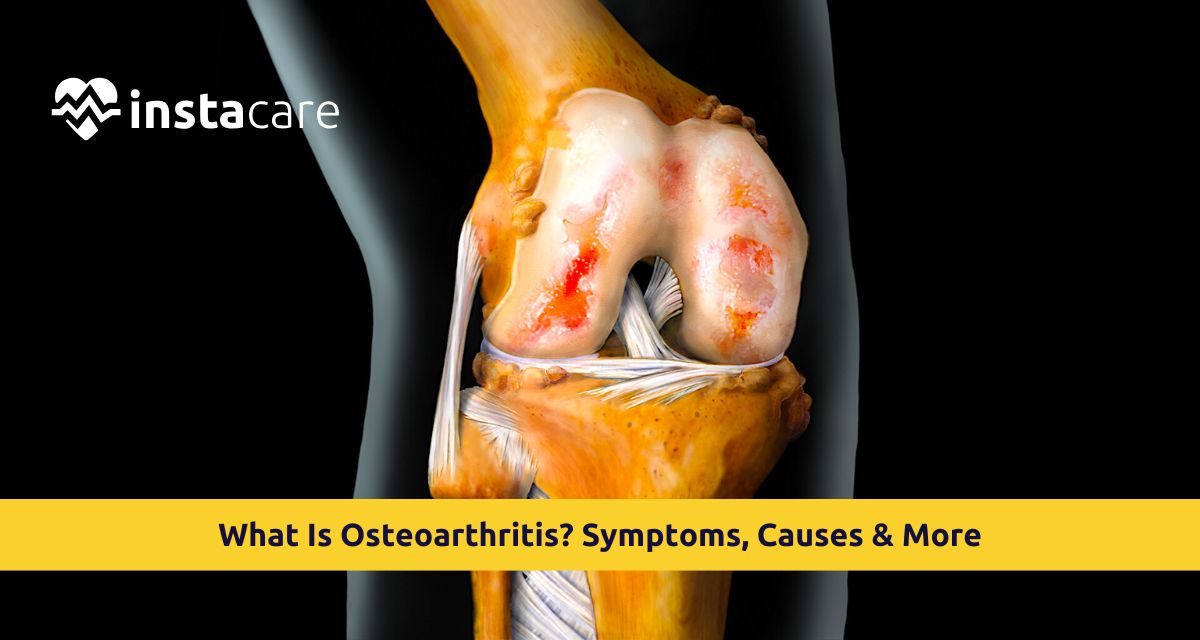Many in the medical field considered the initial signs of osteoarthritis harmless, thus contributing to the term degenerative joint disease for quite some time. Osteoarthritis is the final stage of all articular injuries, such as cartilage degeneration.
That protective cartilage, which in medicine is called osteoarthritis, gets tired out and often sore until it withers away and ultimately becomes non-existent in some patients. It is also known to be one of the most common causes of recurrent pain, stiffness, and impaired joint function.
Symptoms Of Osteoarthritis
Manifestations seen in patients with osteoarthritis range from very mild to very severe Osteoarthritis Symptoms. In most cases, symptoms develop slowly but progress gradually. Thus, the most common osteoarthritis symptoms may include:
- Joint pain aggravated by activity
- Swelling and tenderness around the joint
- Stiffness, especially after inactivity or in the morning
- The limited range of movements in the affected joints
- Bone spurs or lumps over the joint
With time, they inhibit the performance of activities of daily living: it becomes difficult to walk, climb stairs, or even hold goods.
Causes of Osteoarthritis
The complicated part is that there are different contributors to osteoarthritis, and will not always be clear what brings about this condition. Some of the basic Causes of Osteoarthritis include:
- Age: For an increased risk of osteoarthritis. The tendency is that cartilage wears off with time.
- Joint Injuries: Earlier trauma to any joints, such as fractures or ligaments, makes such joints predisposed to osteoarthritis later.
- Genetics: The family history aspect is important in how a person would get osteoarthritis. There are genetic qualities that affect the individual on cartilage degradation.
- Overuse: Repetitive movement or strains to a body part over many years will lead to osteoarthritis. This usually happens in athletes or people with occupations having heavy loads or repetitive activities.
Options Available For Treatment of Osteoarthritis
The Osteoarthritis Treatment Options consist of symptomatic relief and rejuvenation of the joints. These treatments include:
- Medications for Osteoarthritis: Almost all medications for osteoarthritis reliever pain at the joint(s) through over-the-counter methods for treating inflammation or pain. There are two categories of available medications: acetaminophen and NSAIDs, including ibuprofen. Doctors limit prescribing narcotic-based pain medications and corticosteroid injections for arthritis patients to cases when the condition proves severe..
- Osteoarthritis and Physiotherapy: The physical therapist works to enhance the strength and flexibility of joint-supportive muscles to reduce pain.
- Osteoarthritis Pain Management includes heat or cold therapy, acupuncture, and transcutaneous electrical nerve stimulation (TENS).
But when all this fails, when hope is completely lost, then there will be a choice made about surgical techniques, typically joint replacement or arthroscopy.
Best Exercises for Osteoarthritis
This is what anyone suffering from osteoarthritis has to do: establish a consistent Best Exercises for Osteoarthritis plan. Normal joint operation remains in check through exercise activities that prevent joint stiffness. The basic movements within these exercises should be low-impact because they build muscle strength and protect joints against wear and tear. Typically, such exercises include:
- Swimming or water aerobics
- Biking
- Walking
- Strength training with very light weights
- Stretching and yoga
You will undergo improvement in mobility, pain relief, and quality of life within the osteoarthritic population.
Osteoarthritis As Compared To Rheumatoid Arthritis
Although they are described mostly as an affliction of the joints, they have distinct pathological ties. For instance, the distinguishable factor between Osteoarthritis vs Rheumatoid Arthritis is the following:
- Wearing out cartilage over some time and weight-bearing joints such as the knee or hip usually affects other joints in osteoarthritis.
- Healthy and normal tissue is attacked and presents damage and inflammation in the joints because of the immune system's activity against them.
Of course, there is cartilage damage due to Osteoarthritis, and Joint Inflammation may be caused by very many other reasons giving rise to arthritis. In some conditions, repair processes beginning in the damaged cartilage are active factors in causing pain and joint swelling due to inflammation. On the contrary, chronic inflammation will create much more destruction in the long run, leading again to the requirement of effective inflammatory treatment.
Some Home Remedies for Osteoarthritis
Some of the Natural Remedies for Osteoarthritis that are now being researched are used by some persons as adjuncts to their prescribed medications. The following are remedies that have brought them success.
- Turmeric or ginger supplements act by working on the anti-inflammatory mechanism
- Fish oil or flaxseed is high in omega-3 fatty acids-which decrease joint inflammation
- Acupuncture helps with pain and mobility
- Epsom salt baths relieve joint pain and stiffness
Although they relieve pain, one is required to consult a doctor before trying them out, particularly where there is an underlying health issue or one is taking prescription drugs.
Know About Diet and Nutrition in Osteoarthritis
Proper treatment of osteoarthritis demands that joint patients maintain suitable nutrition together with proper dietary choices. The main goal of an osteoarthritis diet combined with a nutrition plan is to reduce inflammatory reactions for maintaining joint health. The following nutrients are essential:
- Fatty acids of omega 3 from fish, like salmon
- Antioxidant-rich fruits and vegetables
- Vitamin D and Calcium for the sake of bone health
- Protein to support muscle strength
A healthy diet will also help with weight maintenance, which is important for relieving stressed joints, especially those in the knees and hips.
Prevention against Osteoarthritis
How to Prevent Osteoarthritis is a hard question, but here are ways to lessen the risk or postpone its occurrence:
- Maintain normal weight.
- Indulge in exercises continuously, especially those with a lower severity.
- Avoid ingrain joint injuries by not doing improper lifting or exercising improper sports techniques.
- Healthy nutrients for joints and bones.
These will help maintain joint well-being and minimize the role of osteoarthritis.
Cartilage Degeneration Osteoarthritis
Cartilage deterioration leads directly to osteoarthritis. Prolonged joint breakdown results in pain and stiffness in affected areas. A lack of proper attention permits this condition to worsen until joint cartilage loses its entire tissue mass and the bones begin grinding against each other. The symptoms intensify, along with joint restrictions in the affected parts.
Osteoarthritis in Knees And Hips
Knees and hips are load-bearing joints susceptible to osteoarthritis. Prolonged use results in varying degrees of wear and tear. Pain, stiffness, and swelling restrict movement. Symptomatic treatment and physical therapy are options, with joint replacements occasionally considered.
Conclusion
Osteoarthritis is not a disease; it is a great affliction among many humans. Today, millions suffer from it worldwide. To be able to live with it, one has to know the signs, causes and remedies. Osteoarthritis and Physical Therapy, pain control, whether using drugs or alternative medicine, will help improve joint movement and exercise. Thus, by preserving their joints, persons with osteoarthritis can live a highly active and fulfilling life.
Please book an appointment with the
best Physiotherapist in Lahore, Karachi, Islamabad, and all major cities of Pakistan through
Instacare, or call our helpline at 03171777509 to find a verified doctor for your disease.

